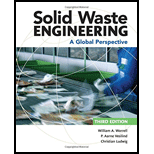
Solid Waste Engineering
3rd Edition
ISBN: 9781305635203
Author: Worrell, William A.
Publisher: Cengage Learning,
expand_more
expand_more
format_list_bulleted
Question
Chapter 4, Problem 4.19P
To determine
The characteristic size of the shredded product.
Expert Solution & Answer
Want to see the full answer?
Check out a sample textbook solution
Students have asked these similar questions
what are the Physical and Mechanical Properties of Plastic Waste with Bricks
V.
DATA AND TABULATION
1. Depending upon the form of the specifications for use of the material under test, the
report shall include the following:
1.1. Total percentage of material passing each sieve, or
1.2. Total percentage of material retained oneach sieve,
or
1.3. Percentage ofmaterial retained between consecutive sieves.
2. Report percentages to the nearest wholenumber, except if the percentage passing the
75-um (No. 200) sieveis less than 10 %, it shall be reported to the nearest 0.1%.
3. Report the fineness modulus, when required, to the nearest 0.01.
CUMULATIVE
CUMULATIVE
SIEV
AMOUNT
AMOUNT
PERCENT
PERCENT
RETAINED, g (b)
RETAINED, 9
(a)
RETAINED,
(c)=(b)*100/TÓT
E
PASSING
SIZ
(d)=100 - (c)
AL
1%
215
885
3/4
980
1/2
2350
3/8
1190
4.
2205
1985
10
1840
40
1650
100
980
200
660
PAN
60
15000
ТОTAL
[7]
Summary:
Because of the amount of handling that occurs during material production, within warehouses, and during manufacturing operations, along with the handling of loading, unloading, and shipping, material mix-ups and mixed materials are not an uncommon occurence. Mixed materials also occur when industrial scrap is collected, or when discarded products are used a new raw material through recycling.
A case of mixed materials has been identified, and you have been called upon to devise a means of separation. Assume that you have the equipment to perform each of the tests described in our discussion. For each of the material combinations below, determine a procedure that could accomplish such a separation. Use standard data-source references to help you identify distinguished properties.
hot-rolled bars of AISI 1020 and 1040 steel
stainless steel sheets of Type 430 ferritic stainless and Type 316 austenitic stainless.
6061-T6 aluminum and AZ91 magnesium that have become mixed in a…
Knowledge Booster
Similar questions
- Draw the free-body diagram of each part of the smooth piston andlink mechanism used to crush recycled cans, shown.arrow_forward8. What is the maximum allowable limit of Materials Finer Than 75 Mm (No. 200) Sieve in Coarse Aggregates in % according ASTM C33? 9. What is the maximum allowable limit (in %) of clay lumps and friable particles in fine and coarse aggregates? 10. What is the maximum allowable limit of loss (in %) of a coarse aggregate sample tested for abrasion and impact in the Los Angeles Abrasion Machine?arrow_forwardlease type your solutions in the box below. Answers without solutions will not have any marks. Students in the materials lab performed the specific gravity test and bulk unit weight and voids of aggregate on a sample of coarse aggregate and obtained the following data: Mass of oven dried aggregate: 951 g Mass of aggregate submerged in water: 603 g Mass of saturated surface dry aggregate: 993 g Find: Bulk dry specific gravity of aggregate. Find the absorption of aggregate. If the dry rodded unit weight of aggregate found to be 1695 kg/m3 , calculate the percent voids between aggregate particles in this test. We blend this aggregate with other aggregate with bulk dry specific gravities of 2.23. Calculate the bulk dry specific gravity of the blend if the blend proportion is 40:60.arrow_forward
- Please show your complete solution on a paper with FBDarrow_forwardDefine the minimum curing period ?arrow_forwardQ2: A: Name three methods of asphalt pavement recycling. Which one of them is the predominant method? Briefly summarize this method. B: What is the fiber saturation point? What is the effect of the fiber saturation point on the shrinkage of wood in the different directions? How does this phenomenon affect the properties of lumber?arrow_forward
- Given the data below: Mass of the Container - 275 grams Mass of the Oven-dried Aggregate + Container - 3145.2 grams Mass of the SSD Aggregate - 3211.2 grams Apparent mass of the Aggregate - 1935.5 grams Compute for the Bulk Specific Gravity of Aggregate in OD condition. a 2.25 b 2.47 c 2.53 d 2.60arrow_forwardthe Nominal Maximum aggregate Size (N.M.S) for the aggregate gradation shown below is equal to Sieve size Passing % 3/4 inch 100 1/2 inch 3/8 inch 99 89 No.4 72 No.8 65 No.30 22 No.200 Your answer 4-arrow_forwardWhat is a Test Sieve? What is a Test Sieve used for? What are the types of Test Sieves? What are the components of a Test Sieve? What is a sieve shaker?arrow_forward
- if total sample mass of aggregate is 164.9 grams, then the percent passing from sieve size #30 only is equal to ………………arrow_forwardReview ASTM D75 and summarize the following:a. Sampling aggregates from conveyer belts.b. Sampling aggregates from stockpiles.c. Sampling aggregates from roadway bases and subbases.d. If the nominal maximum aggregate size is 3/4 in., what is the minimum sample size that needs to be obtained?arrow_forwardWhat is advection and diffusion? Under what conditions can diffusion become an important or even dominant leakage pathway in landfill? Illustrate with simple calculations and sketches.arrow_forward
arrow_back_ios
SEE MORE QUESTIONS
arrow_forward_ios
Recommended textbooks for you
 Solid Waste EngineeringCivil EngineeringISBN:9781305635203Author:Worrell, William A.Publisher:Cengage Learning,
Solid Waste EngineeringCivil EngineeringISBN:9781305635203Author:Worrell, William A.Publisher:Cengage Learning,

Solid Waste Engineering
Civil Engineering
ISBN:9781305635203
Author:Worrell, William A.
Publisher:Cengage Learning,